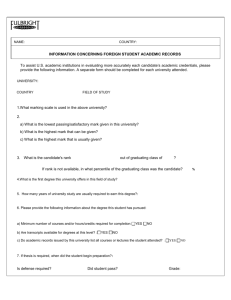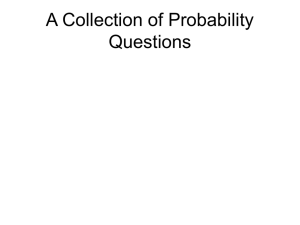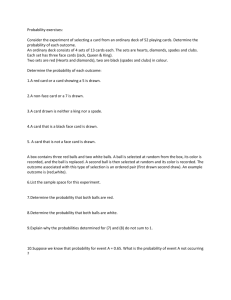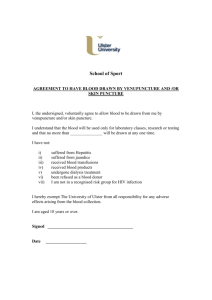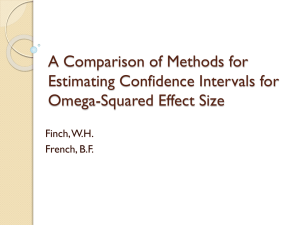CSCI 1900 - Homework 1
advertisement
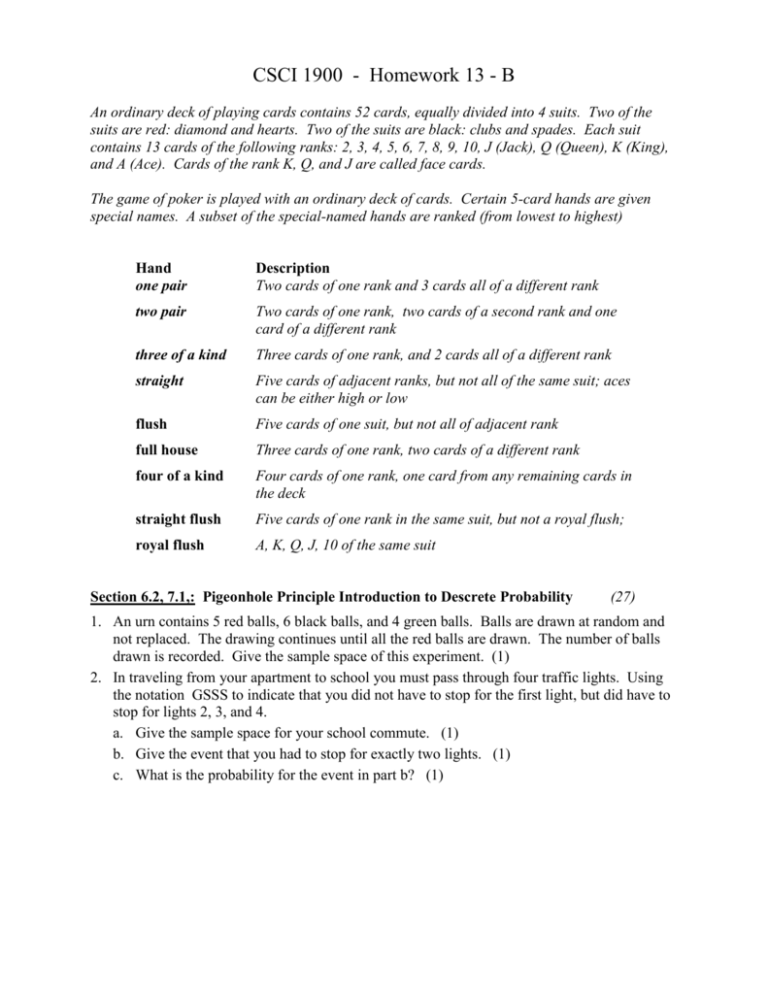
CSCI 1900 - Homework 13 - B
An ordinary deck of playing cards contains 52 cards, equally divided into 4 suits. Two of the
suits are red: diamond and hearts. Two of the suits are black: clubs and spades. Each suit
contains 13 cards of the following ranks: 2, 3, 4, 5, 6, 7, 8, 9, 10, J (Jack), Q (Queen), K (King),
and A (Ace). Cards of the rank K, Q, and J are called face cards.
The game of poker is played with an ordinary deck of cards. Certain 5-card hands are given
special names. A subset of the special-named hands are ranked (from lowest to highest)
Hand
one pair
Description
Two cards of one rank and 3 cards all of a different rank
two pair
Two cards of one rank, two cards of a second rank and one
card of a different rank
three of a kind
Three cards of one rank, and 2 cards all of a different rank
straight
Five cards of adjacent ranks, but not all of the same suit; aces
can be either high or low
flush
Five cards of one suit, but not all of adjacent rank
full house
Three cards of one rank, two cards of a different rank
four of a kind
Four cards of one rank, one card from any remaining cards in
the deck
straight flush
Five cards of one rank in the same suit, but not a royal flush;
royal flush
A, K, Q, J, 10 of the same suit
Section 6.2, 7.1,: Pigeonhole Principle Introduction to Descrete Probability
(27)
1. An urn contains 5 red balls, 6 black balls, and 4 green balls. Balls are drawn at random and
not replaced. The drawing continues until all the red balls are drawn. The number of balls
drawn is recorded. Give the sample space of this experiment. (1)
2. In traveling from your apartment to school you must pass through four traffic lights. Using
the notation GSSS to indicate that you did not have to stop for the first light, but did have to
stop for lights 2, 3, and 4.
a. Give the sample space for your school commute. (1)
b. Give the event that you had to stop for exactly two lights. (1)
c. What is the probability for the event in part b? (1)
For problems 3 and 4, a single card is drawn from an ordinary deck of playing cards. Events D,
Q, and R are defined by the following propositions.
D: The card is a diamond.
Q: The card is a Queen.
R: The card is red.
3. Describe, using D, R, Q, and basic set operations, the following events.
a. The card drawn is the Queen of Diamonds (1)
b. The card drawn is black or a Queen. (1)
c. The card drawn is a red Queen, but not the Queen of Diamonds. (1)
4. Describe the following events in complete English sentences.
a. 𝑅̅ ∪ 𝑄̅ (1)
̅ ∩ 𝑄 (1)
b. 𝐷
c. 𝑅 ∪ (𝐷 ∩ 𝑄̅ ) (1)
For problems 5and 6, a die is tossed twice and the number of pips showing on the top face is
recorded in order.
5. What is the number of events, in which
a. At least one of the numbers is a 2. (1)
b. At least one of the numbers is a 7. (1)
c. The sum of the numbers is greater than 5. (1)
d. The absolute difference between the numbers is greater than 3. (1)
e. The number of pips on the first die divides the number of pips on the second die. (1)
6. A card is drawn from an ordinary deck of playing cards. Consider the following events:
B: The card drawn is a black card.
D: The card drawn is a diamond.
F: The card drawn is a face card.
S: The card drawn has an odd number on it.
a. Compute p(𝑆̅). (1)
b. Compute p(𝐵 ∪ 𝑆). (1)
c. Compute p(𝐹 ∩ 𝐷). (1)
d. Compute p(𝐵 ∩ 𝐷). (1)
e. Compute p(𝐵̅ ∪ 𝐹). (1)
7. Suppose that The First United Geek Bank issues their customers pins that consist of 4
hexadecimal digits. What is the probability that you can guess a customer’s pin on a single
guess? (1)
8. According to the latest Rasselmutton Demican Candidate Poll in a certain southern state,
candidate S is 3 times as likely to win as candidate P, candidate G is twice as likely to win as
candidate S, and candidate R is 4 times as likely to win as candidate P. What is each
candidate’s probability of winning? (1)
9. How many three digits positive integers are divisible by seven? (1)
10. Consider the following poker hands:
a. How many five card hands are possible? (1)
b. What is the probability of being dealt a hand that contains three of a kind? (1)
c. What is the probability of being dealt a hand that contains a full house? (1)
d. What is the probability of being dealt a hand that contains a royal flush? (1)
11. Show that in a small town of 700 residents, at least two people must have the same first and
last initials. (1)
12. If a programmer writes 500 lines of code in 17 days, must there have been at least 1 day in
which the program wrote 30 or more lines per day? Why or why not? (1)
13. Show that if seven different integers are chosen from the set { 3, 4, 5, 6, 7, 8, 9, 10, 11, 12 },
at least two of the integers sum to 15. (1)
14. Show that if five cards are selected from an ordinary deck of playing cards, at least two must
be of the same suit. (1)
15. Show that in a Computer Science class of 30 students, at least five students must be born on
the same day of the week. (1)
